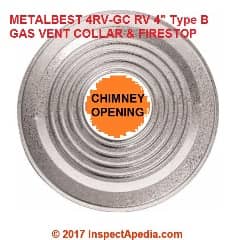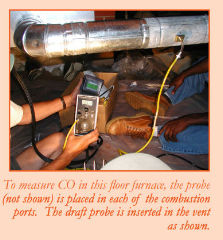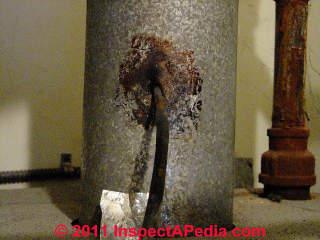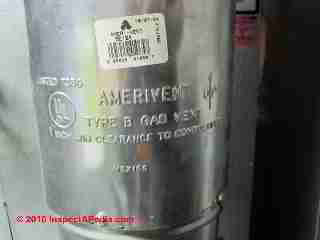 Type B-Vents Ceiling Floor Wall Clearances
Type B-Vents Ceiling Floor Wall Clearances
B-Vent clearances to combustibles
- POST a QUESTION or COMMENT about B-vents chimneys & flues: installation specifications
Metal B-Vent clearance codes & specifications:
Clearance distances for a B-vent to combustible materials in floors, walls, ceilings, attics, roofs.
This article series describes B-vent metal chimneys used for gas-fired appliances. We discuss fire safety, fire clearances, and other gas appliance venting details for b-vent chimneys.
InspectAPedia tolerates no conflicts of interest. We have no relationship with advertisers, products, or services discussed at this website.
Ceiling, Wall & Wall Clearances for B-Vent "flue pipes"
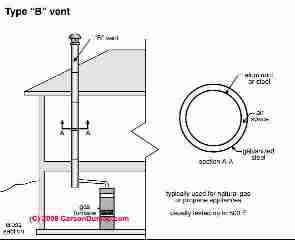
Type B Chimney Fire Clearance Details
Sketch of a Type "B" vent provided courtesy of Carson Dunlop Associates [at REVIEWERS], a Toronto home inspection, education & report-writing firm. [Click to enlarge any image]
Type B-vents are double-walled metal chimneys/flues and can be used only with listed, draft-hood equipped gas appliances.
A Type B vent is intended for relatively low-heat applications.
B-vents are not permitted for use with incinerators and are not intended for use with appliances burning anything other than LP or natural gas.
Interior Installations of Gas Vent Connectors in all Buildings
Where the chimney extends through any zone of a building (outside that in which the heating appliance connected to it is located), it shall be provided with an enclosure having a fire resistance rating equal to or greater than that of the floor, ceiling, wall or roof assemblies through which it passes. (Selkirk 2015)
Vertical (Floor, Ceiling and Roof) Penetrations
All vertical penetrations where the vent passes through a combustible floor, ceiling or roof, require a Fire Stop (p/n 5x18CI) or Roof Jack be installed.
See Table 1 for proper framing dimension and refer to the Fire Stop or Roof Jack Section for proper installation. Non-combustible Floor, Ceiling & Roof Penetrations do not require a Fire Stop or Roof Jack. (Selkirk 2015)
Horizontal (Wall) Penetrations
Horizontal systems passing through a combustible wall require the use of a Wall Penetration, for relative temperatures with clearances. See Table 1 for proper framing dimensions and refer to Wall Penetration section for installation instructions.
Non-combustible wall penetrations do not require a Wall Penetration. - (HeatFab 2015)
1) If a ceiling or wall has a fire resistance rating and is penetrated by a Models G, PS, or IPS Grease Duct, then the duct shall be enclosed with a continuous enclosure extending from the penetration, through any concealed spaces, to or through the roof so as to maintain the integrity of the fire separations required by the applicable building code.
NOTE: If penetrated by Z3 or Z4 no additional enclosure is required however the appropriate Through Penetration Firestop (TPF) must be used. See Through Penetration Section.
2) If a ceiling or wall does not have a fire resistance rating and is penetrated by a Model G, PS or IPS Grease Duct installed at the correct minimum clearance for unenclosed duct, then no enclosure is required.
3) Where the Model G, PS and IPS ducting extends through any story of a commercial building above that in which the connected appliances are located, it must be enclosed in the upper stories with walls having a fire resistance rating of not less than one hour for buildings of two or three stories in height.
If the commercial building is four stories or more in height, the enclosure wall shall have a fire resistance rating of not less than two hours. (Selkirk 2015)
Question: For a propane furnace flue pipe how much clearance is needed through ceiling area?
Brenda Grant said:
For a flue pipe from a propane furnace how much clearance is needed as it goes through ceiling area?
Can one put in metal mesh to prevent insects or critters from coming down from the attic?
This question was posted originally at FIRE CLEARANCES, SINGLE WALL METAL FLUES & VENTS
Reply: use a ceiling shield, wall shield, collar, support that is Listed, Approved as a fire block and for fire safety
Brenda:
Where a metal chimney passes through building floors, ceilings, walls,
Most-common gas vent
If you are using a B-vent (a double-walled air-insulated vent for gas appliances) typically you'll see a fire clearance stamped right into the metal of the chimney, stating 1-inch MINIMUM clearance to combustibles - as you'll see in this photo
[Click to enlarge any image] You'll see that the manufacturer, Amerivent has stamped this Type B gas vent as requiring 1" clearance to combustibles.
If you cannot meet the 1-inch B-vent clearance you may be able to use a zero-clearance chimney material.
Possible gas vent
If you are using a "zero-clearance" insulated chimney such as CLASS A CHIMNEYS, MetalBestos™ the product label might it for zero clearance - or rated for in-contact with combustibles.
However a review of contemporary insulated chimneys such as the SuperVent and SuperPro by Selkirk frequently require a 2" fire clearance around most penetrations through building walls, floors, ceilings, roofs, unless the wall or floor is made of noncombustible material (like concrete).
Unlikely: single wall propane gas appliance vent
As you've read above, a B-vent is the proper venting connection between a conventional LP gas or natural gas heating appliance and the outdoors.
Occasionally we find an older installation of a gas fired heater that uses a single-wall metal flue between the appliance and a masonry chimney: this might be acceptable depending on local codes and restrictions where you live, if proper fire clearance distances are kept.
The proper term for this connector is a "flue vent connector" but plenty of normal people use the word "flue" or the phrase "stack pipe" loosely for any sort of chimney or chimney connector.
Watch out: a single wall metal flue vent is not safe if it passes through combustible floors, walls, ceilings, roofs.
See FIRE CLEARANCES, SINGLE WALL METAL FLUES & VENTS
How to Cover the Open Fire-Clearance Gap at B-vent Passage through Walls or Ceilings
Watch out: You do NOT and should NOT use a home-made insect screen to cover the fire clearance opening.
Rather you should buy a UL-Listed (approved for fire safety) Type B Gas Vent collar and firestop such as the MetalBest 104460 Galvanized RV 4" Type B gas vent collar and firstop or such as the MetalBest RV-GC shown in the photo below. The products you use for this application, if you're in North America, should be Tested and Listed to UL1738 & ULC S636.
and widely available from your heating and plumbing supplier, building supply stores, and even online at Walmart.
Watch out: even using light-weight B-vent chimney sections, the total weight of the chimney extending up through the roof will require support at one or more locations, typically using a ceiling support, attic support, or roof support system provided by the manufacturer. Additional fire blocking and shields are required at each of those passages.
Watch out: Keep in mind that a building permit and inspection is usually required for installing a heating appliance and its vent or chimney - something that you might think you won't enjoy but something should ask-for, since the inspection will improve the safety of your home.
B-Vent Chimney Codes & Installation Manuals
- More details about Type B metal chimney fire clearances indoors can be read at FIRE CLEARANCES, METAL CHIMNEYS.
- See CHIMNEY CODES for our complete list of online chimney code PDF files.
- Chapter 5, Chimneys and Vents, Section 501 (IFGC), [PDF] (2015) Seattle building code, Retrieved 2017/07/22, original source: http://www.seattle.gov/dpd/cs/groups/pan/@pan/documents/web_informational/p2622099.pdf
- DURA VENT METAL CHIMNEY INSTALLATION INSTRUCTIONS [PDF] retrieved 2018/02/12, original source: Dura Vent, 877 Cotting Court, Vacaville, CA 95688 USA Tel: 800.835.4429 Fax: 707.446.4740 Email: customerservice@duravent.com retrieved 2018/02/12 at https://www.duravent.com/docs/product/L150_W.pdf
- Hart & Cooley, TYPE B GAS VENT 3-13" DIAMETER INSTALLATION INSTRUCTIONS [PDF} retrieved 2022/02/11 original source: https://www.hartandcooley.com/assets/files/o4/150952-typebgasvent-130116.pdf
- Saf-T Vent® Model EZ Seal and Model GC Single Wall AL 29-4C Stainless Steel Gas Vent Connector Chimney Liner & Special Gas Vent (USA) / Type BH Vent Class I/II (Canada) [PDF],
For Venting Residential, Commercial & Industrial Appliances Category I, II, III & IV Appliances, HeatFab, 5030 Corporate Exchange Blvd., Grand Rapids MI 49512 USA, Tel: 800-772-0739, Website: www.heatfab.com retrieved 2017/07/22, original source: http://heatfab.com/~/media/pigcins07302015.pdf - Selkirk® Commecial & Industrial MODEL G, PS, IPS & ZC SINGLE WALL, DOUBLE WALL AIR & CERAMIC FIBER INSULATED POSITIVE PRESSURE PIPING SYSTEMS Boiler Exhaust, Engine Exhaust, Grease Duct, [PDF]
Commercial/Industrial Venting Products Sales Office Selkirk Corporation 5030 Corporate Exchange Blvd SE Grand Rapids, MI 49512 USA Tel: 800.848.2149 Selkirk Canada Corporation 375 Green Road Stoney Creek, ON L8E4A5 Tel: 888.735.5475 Website: www.selkirkcommercial.com retrieved 2017/07/22, original source: http://selkirkcommercial.com/~/media/selkirk/reference-documents/ common/file/installation/pressure-stacks/ model-psipspressure-stack/installation-instructionsmaintenanceguide.pdf
Excerpt:
An Attic Insulation Shield must be installed where a chimney passes from a lower living space into an upper living space or into an attic space. It is designed to keep insulation materials from coming into contact with the chimney and will protect up to a 10" (250 mm) thickness of insulation.
Where height restrictions will not permit the use of the Attic Insulation Shield, an enclosure from the attic joist to the roof joist will be sufficient. All chimney enclosures must maintain the required minimum air space clearance of 2" (50mm) to the chimney.
When enclosing the chimney below the roof line, a Rafter Radiation Shield (RRS) must be installed at the roof level ... - UL 103 Type HT
- UL1738
- ULC S636
- CAN/ULC S629
Reader Comments, Questions & Answers About The Article Above
Below you will find questions and answers previously posted on this page at its page bottom reader comment box.
Reader Q&A - also see RECOMMENDED ARTICLES & FAQs
On 2022-02-11 by Inspectapedia Com Moderator - Can you drill a test hole in the B-vent to measure draft?
@Nate,
Continuing: you can show the photo below to your local inspector - it's from COMBUSTION APPLIANCE SAFETY & EFFICIENCY TESTING [PDF] U.S. Department of Energy
On 2022-02-11 by Inspectapedia Com Moderator
@Nate,
Continuing:
Your code inspector may be familiar with some metal chimney installations such as DuraVent that include chimney section instructions stating:
"DRILL 1/8 INCH DIAMETER
HOLE. DO NOT PENETRATE
INNER LINER"
But that is pertaining to chimney assembly and should not prevent making the necessary opening to perform needed combustion and draft tests.
On 2022-02-11 by Inspectapedia Com Moderator
@Nate,
Perhaps the inspector worries that you've damaged the B-vent, though I'm doubtful that the effect of a drilled 1/4" hole for a test probe could be measured or detected.
Usually on gas fired heating equipment there is a single-wall galvanized steel flue vent connector between the boiler or furnace exhaust outlet and the entry to the B-vent chimney itself.
It'd be better to make a test opening there so as to avoid an argument about messing with a muti-wall B-vent.
Typically we measure draft in that space - the breech - maybe 2-6" above the top of the heater itself. Measuring draft much higher in the flue might not give the best heater draft or combustion air adjustment results.
We've been doing that since 1976 without an issue with anybody.
Details are at DRAFT MEASUREMENT, CHIMNEYS & FLUES
I'm not clear what your local inspector's worry is about. The exhaust vent on gas fired heater flues and vents is at negative pressure - so if there were any effect of the 1/4" diameter test probe hole ( as instructed by every draft gauge and heating test instrument manufacturer) it would be the drawing-IN of a very small amount of air into the exhaust flue: not enough to measurably affect the draft.
Bottom line: the authorities that I've found (eg. cited below) state that it is perfectly acceptable to drill a test hole in the B-vent to measure draft.
"“B” Vent is a double wall pipe with an outer layer of galvanized steel and an inner layer
made of aluminum. It is commonly used to vent gas fired appliances (with negative
pressure draft) and it is acceptable practice to drill a test hole in this type of flue pipe to
perform combustion and/or draft testing. " - source: "Appendix A: Combustion Appliance Protocols
Clean, Tune & Evaluation Requirements" [PDF] - State of Vermont, retrieved 2022/02/11 original source: https://dcf.vermont.gov/sites/dcf/files/OEO/WAP/WAP-Manual-AppendixA.pdf
Copy here at
COMBUSTION APPLIANCE PROTOCOLS CLEAN, TUNE & EVALUATION REQUIREMENTS [PDF]
If at a installation there is no length of single wall flue vent connector (a B-vent is connected directly to the heater) have you considered just cutting a neat square of aluminum stick-on tape to cover the test opening after making a measurement.
On 2022-02-11 by Nate
do you approve a hole being made in the B vent near a furnace, boiler etc for a combustion analyzer to be inserted? or are there any manufacturer forms saying as much?
local inspector giving us a bunch of BS on it but ive been doing it for 18 years and has always been common practice. looking for supporting info that it is approved by b vent manufacturers
On 2021-11-27 by Inspectapedia Com Moderator
It's correct that you don't modify listed chimney parts or the result could be a fire or carbon monoxide hazards.
Also it's generally the case that too many on bends interferes with the draft so that the equipment is not vented safely or properly.
You can box around a metal chimney if you respect the required higher clearances but you want to be sure to design your enclosure so that there is access for inspection , cleaning,, or repair.
On 2021-11-27 by Lisa
We have a decent size dead space in our 1st floor hallway that contains our 4" b-vent ductwork from our basement hot water heater. There is a firestop where the b-vent comes through the 1st floor.
In all my research, it appears that the b-vent cannot be cut and multiple 45 or 90 angle pieces cannot be inserted to move the b-vent into a better location. Am I correct? We really wanted to be able to reclaim this space for a hall closet.
If we forego relocating the b-vent, can we box around the b-vent with at least the minimum of 1" clearance around the b-vent?
On 2021-08-12 by Walter Dick
@inspectapedia.com.moderator,
Thanks for your reply. Yes it is a 4-sided chase that contains a B vent. This is on the main floor of our bungalow. The gas water heater is in the basement and the flue continues through the unfinished attic space and out the roof. I haven't opened the chase yet so don't know if it has drywall on the inner side of the wood studs.
On 2021-08-11 by Inspectapedia Com Moderator
@Walter Dick,
I'm unclear what sort of "wall" and what you mean by "inside the wall" we're discussing, so I can't give you a clear "yes that's fine" - let me explain:
A "wall" to me is a structure framed with 2x4 or 2x6 lumber (or metal studs) faced on two sides, possibly an interior partition wall or an exterior wall, possibly structural.
The cavity space in a wall is just 3 1/2" or may be 5 1/2" in depth and in width it's the stud spacing, e.g. 15 1/2" - so it's not likely that a gas water heater is routed inside such a wall.
A water heater B-vent might however be routed THROUGH such a wall.
As long as you seal the wall penetration for the wire properly and the wires are clear away from the B-vent itself - respecting its clearance distances (see this page above) that's ok.
If by "wall" you actually meant a framed chaseway for a chimney - a 4-sided structure that routes the B-vent chimney up to and through the roof to the exterior,
with the same caveats as I gave above on clearance and fire-rated sealants at penetrations, it's common to run wires in such a chaseway.
Beware that because chimney chases themselves have fire blocking requirements, penetrations for the wire as it runs through a chase also have to meet those fire block requirements. Typically that means using a special fire-rated sealant at the penetrations.
In general you can run wires in a chimney chase
On 2021-08-11 by Walter Dick
Can I add electric wiring and switches/outlets inside an existing wall that encloses a b vent for a gas water heater?
On 2021-06-02 by Inspectapedia Com Moderator
@jeff levitch,
Watch out: Do not run single-wall connectors through unheated spaces, partitions, or in concealed areas. That's a fire and gas leak hazard.
Source: Hart & Cooley, TYPE B GAS VENT INSTALLATION INSTRUCTIONS [PDF] (2015) Hart & Cooley Co., 5030 Corporate Exchange Blvd. SE, Grand Rapids, MI 49512 USA, Tel: (800) 433-6341 Email: info@hartcool.com Website: https://www.hartandcooley.com,
retrieved 2021/06/02 original source: https://www.hartandcooley.com/assets/files/o4/150952-typebgasvent-130116.pdf
On 2021-06-02 by jeff levitch
Is it a code violation to put a type b vent (with a joint) through a "concealed space". ( MORE THAN 6" WIDE)?
On 2020-01-13 - by (mod) -
Flue
In addition to the flue clearance data given above on this page and cited in the PDF files we provide also in this article series, take a look at the imprint, stamping, or labels right on your B vent. I bet you'll see that it specifies one inch to combustibles.
On 2020-01-13 by flue pipe clearance
What is the distance for a flue pipe to vinyl siding?
On 2019-11-16 - by (mod) -
Anon
Please use the search box just above on this page to search for
Water heater pressure relief valve
And you will see our articles that will answer just about any question you may have
On 2019-11-16 by Anonymous
Water heater pressure release vavle
Proper pressure
On 2019-06-08 - by (mod) -
Let's start by identifying the brand of your chimney. Then we'll take a look at the installation instructions from that manufacturer.
On 2019-06-07 by Stephen
A previous homeowner installed a triple wall 8" flue through the ceiling from a fireplace with no Firestop or ceiling support box, how do I enclose the ceiling whole after the chimney has already been installed?
On 2018-10-06 - by (mod) -
Will
The final legal answer to your excellent question is in the hands of your local building code inspector who in turn may ask what the chimney manufacturer said.
My opinion is that there wouldn't be a functional issue with a slope but there may be leak issues around the chimney if you use non- factory angles, boots, flashing.
On 2018-10-05 by Will
Does b vent have to penetrate through the roof vertically or can it have a slight slope to ot?
...
Continue reading at TYPE B-VENT ROOFTOP CLEARANCE or select a topic from the closely-related articles below, or see the complete ARTICLE INDEX.
Or see these
Recommended Articles
- ADJACENT METAL CHIMNEY SEPARATION - separation between metal chimneys and their rain caps
- HEIGHT REQUIRED for L VENTS & B VENTS
- METAL CHIMNEYS & FLUES - home
- METAL CHIMNEY INSTALLATION MANUALS
- TYPE B-VENT CHIMNEYS - home
- TYPE B-VENT IDENTIFICATION LABELS
- TYPE B VENT vs L VENT DIFFERENCES
- TYPE B-VENT ERRORS
- TYPE B-VENT CEILING FLOOR WALL CLEARANCES
- TYPE B-VENT ROOFTOP CLEARANCE
Suggested citation for this web page
TYPE B-VENT CEILING FLOOR WALL CLEARANCES at InspectApedia.com - online encyclopedia of building & environmental inspection, testing, diagnosis, repair, & problem prevention advice.
Or see this
INDEX to RELATED ARTICLES: ARTICLE INDEX to CHIMNEYS & FLUES
Or use the SEARCH BOX found below to Ask a Question or Search InspectApedia
Ask a Question or Search InspectApedia
Try the search box just below, or if you prefer, post a question or comment in the Comments box below and we will respond promptly.
Search the InspectApedia website
Note: appearance of your Comment below may be delayed: if your comment contains an image, photograph, web link, or text that looks to the software as if it might be a web link, your posting will appear after it has been approved by a moderator. Apologies for the delay.
Only one image can be added per comment but you can post as many comments, and therefore images, as you like.
You will not receive a notification when a response to your question has been posted.
Please bookmark this page to make it easy for you to check back for our response.
Our Comment Box is provided by Countable Web Productions countable.ca
Citations & References
In addition to any citations in the article above, a full list is available on request.
- Mark Cramer Inspection Services Mark Cramer, Tampa Florida, Mr. Cramer is a past president of ASHI, the American Society of Home Inspectors and is a Florida home inspector and home inspection educator. Mr. Cramer serves on the ASHI Home Inspection Standards. Contact Mark Cramer at: 727-595-4211 mark@BestTampaInspector.com
- John Cranor [Website: /www.house-whisperer.com ] is an ASHI member and a home inspector (The House Whisperer) is located in Glen Allen, VA 23060. He is also a contributor to InspectApedia.com in several technical areas such as plumbing and appliances (dryer vents). Contact Mr. Cranor at 804-873-8534 or by Email: johncranor@verizon.net
- Thanks to Luke Barnes for suggesting that we add text regarding the hazards of shared chimney flues. USMA - Sept. 2008.
- Arlene Puentes [Website: www.octoberhome.com ] , an ASHI member and a licensed home inspector in Kingston, NY, and has served on ASHI national committees as well as HVASHI Chapter President. Ms. Puentes can be contacted at ap@octoberhome.com
- Roger Hankeyis principal of Hankey and Brown home inspectors, Eden Prairie, MN, technical review by Roger Hankey, prior chairman, Standards Committee, American Society of Home Inspectors - ASHI. 952 829-0044 - hankeyandbrown.com
- NFPA 211 - Standards for Chimneys & Fireplaces, NFPA 211: Standard for Chimneys, Fireplaces, Vents, and Solid Fuel-Burning Appliances, 2006 Edition (older editions and standards are found at the same bookstore)
- NFPA #211-3.1 1988 - Specific to chimneys, fireplaces, vents and solid fuel burning appliances.
- NFPA # 54-7.1 1992 - Specific to venting of equipment with fan-assisted combustion systems.
- GAMA - Gas Appliance Manufacturers' Association has prepared venting tables for Category I draft hood equipped central furnaces as well as fan-assisted combustion system central furnaces.
- National Fuel Gas Code, an American National Standard, 4th ed. 1988 (newer edition is available) Secretariats, American Gas Association (AGA), 1515 Wilson Blvd., Arlington VA22209, and National Fire Protection Association (NFPA), Batterymarch Park, Quincy MA 02269. ANSI Z223.1-1988 - NFPA 54-1988. WARNING: be sure to check clearances and other safety guidelines in the latest edition of these standards.
- Fire Inspector Guidebook, A Correlation of Fire Safety Requirements Contained in the 1987 BOCA National Codes, (newer edition available), Building Officials and Code Administrators International, Inc. (BOCA), Country Club HIlls, IL 60478 312-799-2300 4th ed. Note: this document is reissued every four years. Be sure to obtain the latest edition.
- Uniform Mechanical Code - UMC 1991, Sec 913 (a.) Masonry Chimneys, refers to Chapters 23, 29, and 37 of the Building Code.
- New York 1984 Uniform Fire Prevention and Building Code, Article 10, Heating, Ventilating, and Air Conditioning Requirements
- New York 1979 Uniform Fire Prevention & Building Code, The "requirement" for 8" of solid masonry OR for use of a flue liner was listed in the One and Two Family Dwelling Code for New York, in 1979, in Chapter 9, Chimneys and Fireplaces, New York 1979 Building and Fire Prevention Code:
- "Top Ten Chimney (and related) Problems Encountered by One Chimney Sweep," Hudson Valley ASHI education seminar, 3 January 2000, contributed by Bob Hansen, ASHI
- Chimney Inspection Checklist, Carson Dunlop, Associates, Toronto, Ontario
- "Rooftop View Turns to Darkness," Martine Costello, Josh Kovner, New Haven Register, 12 May 1992 p. 11: Catherine Murphy was sunning on a building roof when a chimney collapsed; she fell into and was trapped inside the chimney until rescued by emergency workers.
- "Chimneys and Vents," Mark J. Reinmiller, P.E., ASHI Technical Journal, Vol. 1 No. 2 July 1991 p. 34-38.
- "Chimney Inspection Procedures & Codes," Donald V. Cohen was to be published in the first volume of the 1994 ASHI Technical Journal by D. Friedman, then editor/publisher of that publication. The production of the ASHI Technical Journal and future editions was cancelled by ASHI President Patrick Porzio. Some of the content of Mr. Cohen's original submission has been included in this more complete chimney inspection article: CHIMNEY INSPECTION DIAGNOSIS REPAIR . Copies of earlier editions of the ASHI Technical Journal are available from ASHI, the American Society of Home Inspectors.
- "Chimneys and Vents", 789 CMR 68.00 Massachusetts Building Code, web search 10/15/2010, original source:
http://www.mass.gov/Eeops/docs/dps/780%20CMR/780068.pdf 03/23/2007
780 CMR: STATE BOARD OF BUILDING REGULATIONS AND STANDARDS THE MASSACHUSETTS STATE BUILDING CODE - quoting:
6801.11 Multiple-Appliance Venting Systems. Two or more listed and labeled fossil fuel-fired appliances shall not be connected to a common natural draft venting system unless permitted per applicable requirements of 248 CMR or 527 CMR. For solid fuel-burning appliances, see 780 CMR 6801.12. - Chimneys and Vents, Chapter 18, M1801,model building code - [on file as Code_Chim_Res_C_18.pdf] - widely used by U.S. & Canadian Municipalities,
- "Model DFS L-Vent / Type B Gas Vent Installation Instructions", Selkirk Corporation, 5030 Corporate Exchange Blvd., Grand Rapids MI 49512, Tel: 800-433-6341 & Selkirk Canada Corporation, PO Box 526, Depot 1, Hamilton ON L8L 7X6, 888-735-5475, web search 10/15/2010, original source: www.mass.gov/Eeops/docs/dps/780%20CMR/780068.pdf
- "Type L Temperature Venting Systems [on file as L_Vent_Metal_Fab.pdf] - ", Installation and Maintenance Instructions, Metal-Fab Inc., PO Box 1138, Sichita KS 67201, 316-943-2351, Email: info@mtl-fabinc.com website: www.mtl-fabinc.com
- "Type L Vent Vent for Oil/Gas Fired Appliances, Installation and Maintenance Manual", Energy Vent Ltd., 241 Arvin Ave., Stoney Creek Ontario Canada L8E 2L9, web search 10/15/2010 original source: www.selkirkcorp.com/WorkArea/downloadasset.aspx?id=2380 www.selkirkcorp.com/WorkArea/downloadasset.aspx?id=1802
- Natural Gas Weekly Update: http://tonto.eia.doe.gov/oog/info/ngw/ngupdate.asp Official Energy Statistics from the U.S. Government
- US Energy Administration: Electrical Energy Costs http://www.eia.doe.gov/fuelelectric.html
- Our recommended books about building & mechanical systems design, inspection, problem diagnosis, and repair, and about indoor environment and IAQ testing, diagnosis, and cleanup are at the InspectAPedia Bookstore. Also see our Book Reviews - InspectAPedia.
- Ceramic Roofware, Hans Van Lemmen, Shire Library, 2008, ISBN-13: 978-0747805694 - Brick chimneys, chimney-pots and roof and ridge tiles have been a feature of the roofs of a wide range of buildings since the late Middle Ages. In the first instance this ceramic roofware was functional - to make the roof weatherproof and to provide an outlet for smoke - but it could also be very decorative.
The practical and ornamental aspects of ceramic roofware can still be seen throughout Britain, particularly on buildings of the Victorian and Edwardian periods. Not only do these often have ornate chimneys and roof tiles but they may also feature ornamental sculptures or highly decorative gable ends. This book charts the history of ceramic roofware from the Middle Ages to the present day, highlighting both practical and decorative applications, and giving information about manufacturers and on the styles and techniques of production and decoration.
Hans van Lemmen is an established author on the history of tiles and has lectured on the subject in Britain and elsewhere. He is founder member and presently publications editor of the British Tiles and Architectural Ceramics Society. - Chimney Inspection Checklist, Carson Dunlop, Associates, Toronto, Ontario
- Chimney & Stack Inspection Guidelines, American Society of Civil Engineers, 2003 - These guidelines address the inspection of chimneys and stacks. Each guideline assists owners in determining what level of inspection is appropriate to a particular chimney and provides common criteria so that all parties involved have a clear understanding of the scope of the inspection and the end product required. Each chimney or stack is a unique structure, subject to both aggressive operating and natural environments, and degradation over time. Such degradation may be managed via a prudent inspection program followed by maintenance work on any equipment or structure determined to be in need of attention. Sample inspection report specifications, sample field inspection data forms, and an example of a developed plan of a concrete chimney are included in the guidelines. This book provides a valuable guidance tool for chimney and stack inspections and also offers a set of references for these particular inspections.
- Fireplaces, a Practical Design Guide, Jane Gitlin
- Fireplaces, Friend or Foe, Robert D. Mayo
- NFPA 211 - Standards for Chimneys & Fireplaces, NFPA 211: Standard for Chimneys, Fireplaces, Vents, and Solid Fuel-Burning Appliances, 2006 Edition (older editions and standards are found at the same bookstore)
- Principles of Home Inspection: Chimneys & Wood Heating, in (Principles of Home Inspection), Carson Dunlop, Associates, Toronto, Ontario
- NFPA 211 - 3-1.10 - Relining guide for chimneys
- NFPA 211 - 3-2 - Construction of Masonry Chimneys
- NFPA 211 - 3-3 - Termination Height for chimneys
- NFPA 211 - 3-4 - Clearance from Combustible Material
- NFPA 54 - 7-1 - Venting of Equipment into chimneys
- Brick Institute of America - Flashing Chimneys
Brick Institute of America - Proper Chimney Crowns
Brick Institute of America - Moisture Resistance of Brick - American Gas Association - New Vent Sizing Tables
- Chimney Safety Institute of America - Chimney Fires: Causes, Effects, Evaluation
- National Chimney Sweep Guild - Yellow Pages of Suppliers
- In addition to citations & references found in this article, see the research citations given at the end of the related articles found at our suggested
CONTINUE READING or RECOMMENDED ARTICLES.
- Carson, Dunlop & Associates Ltd., 120 Carlton Street Suite 407, Toronto ON M5A 4K2. Tel: (416) 964-9415 1-800-268-7070 Email: info@carsondunlop.com. Alan Carson is a past president of ASHI, the American Society of Home Inspectors.
Thanks to Alan Carson and Bob Dunlop, for permission for InspectAPedia to use text excerpts from The HOME REFERENCE BOOK - the Encyclopedia of Homes and to use illustrations from The ILLUSTRATED HOME .
Carson Dunlop Associates provides extensive home inspection education and report writing material. In gratitude we provide links to tsome Carson Dunlop Associates products and services.


